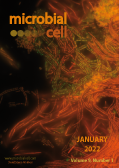Table of contents
Volume 9, Issue 1, pp. 1 - 23, January 2022
Cover: Fluorescent microscopic picture showing a mixed biofilm of two bacterial strains corresponding to the Staphylococcus and Bacillus genus, respectively (image by SandraG89, retrieved via Wikimedia Commons and modified by MIC). The cover is published under the Creative Commons Attribution (CC BY) license.
Enlarge issue cover
Detection of severe acute respiratory syndrome coronavirus 2 (SARS-CoV-2) and its first variants in fourplex real-time quantitative reverse transcription-PCR assays
Mathieu Durand, Philippe Thibault, Simon Lévesque, Ariane Brault, Alex Carignan, Louis Valiquette, Philippe Martin and Simon Labbé
Research Reports |
page 1-20 | 10.15698/mic2022.01.767 | Full text | PDF |
Abstract
The early diagnosis of severe acute respiratory syndrome coronavirus 2 (SARS-CoV-2) infections is required to identify and isolate contagious patients to prevent further transmission of SARS-CoV-2. In this study, we present a multitarget real-time TaqMan reverse transcription PCR (rRT-PCR) assay for the quantitative detection of SARS-CoV-2 and some of its circulating variants harboring mutations that give the virus a selective advantage. Seven different primer-probe sets that included probes containing locked nucleic acid (LNA) nucleotides were designed to amplify specific wild-type and mutant sequences in Orf1ab, Envelope (E), Spike (S), and Nucleocapsid (N) genes. Furthermore, a newly developed primer-probe set targeted human β2-microglobulin (B2M) as a highly sensitive internal control for RT efficacy. All singleplex and fourplex assays detected £ 14 copies/reaction of quantified synthetic RNA transcripts, with a linear amplification range of nine logarithmic orders. Primer-probe sets for detection of SARS-CoV-2 exhibited no false-positive amplifications with other common respiratory pathogens, including human coronaviruses NL63, 229E, OC43, and HKU-1. Fourplex assays were evaluated using 160 clinical samples positive for SARS-CoV-2. Results showed that SARS-CoV-2 viral RNA was detected in all samples, including viral strains harboring mutations in the Spike coding sequence that became dominant in the pandemic. Given the emergence of SARS-CoV-2 variants and their rapid spread in some populations, fourplex rRT-PCR assay containing four primer-probe sets represents a reliable approach to allow quicker detection of circulating relevant variants in a single reaction.
The small bowel microbiome changes significantly with age and aspects of the ageing process
Gabriela Leite, Mark Pimentel, Gillian M. Barlow and Ruchi Mathur
Microreviews |
page 21-23 | 10.15698/mic2022.01.768 | Full text | PDF |
Abstract
Gut microbiome changes have been associated with human ageing and implicated in age-related diseases including Alzheimer’s disease and Parkinson’s disease. However, studies to date have used stool samples, which do not represent the entire gut. Although more challenging to access, the small intestine plays critical roles in host metabolism and immune function. In this paper (Leite et al. (2021), Cell Reports, doi: 10.1016/j.celrep.2021.109765), we demonstrate significant differences in the small intestinal microbiome in older subjects, using duodenal aspirates from 251 subjects aged 18-80 years. Differences included significantly decreased microbial diversity in older subjects, driven by increased relative abundance of phylum Proteobacteria, particularly family Enterobacteriaceae and coliform genera Escherichia and Klebsiella. Moreover, while this decreased diversity was associated with the ‘ageing process’ (comprising chronologic age, number of medications, and number of concomitant diseases), changes in certain taxa were found to be associated with number of medications alone (Klebsiella), number of diseases alone (Clostridium, Bilophila), or chronologic age alone (Escherichia, Lactobacillus, Enterococcus). Lastly, many taxa associated with increasing chronologic age were anaerobes. These changes may contribute to changes in human health that occur during the ageing process.










